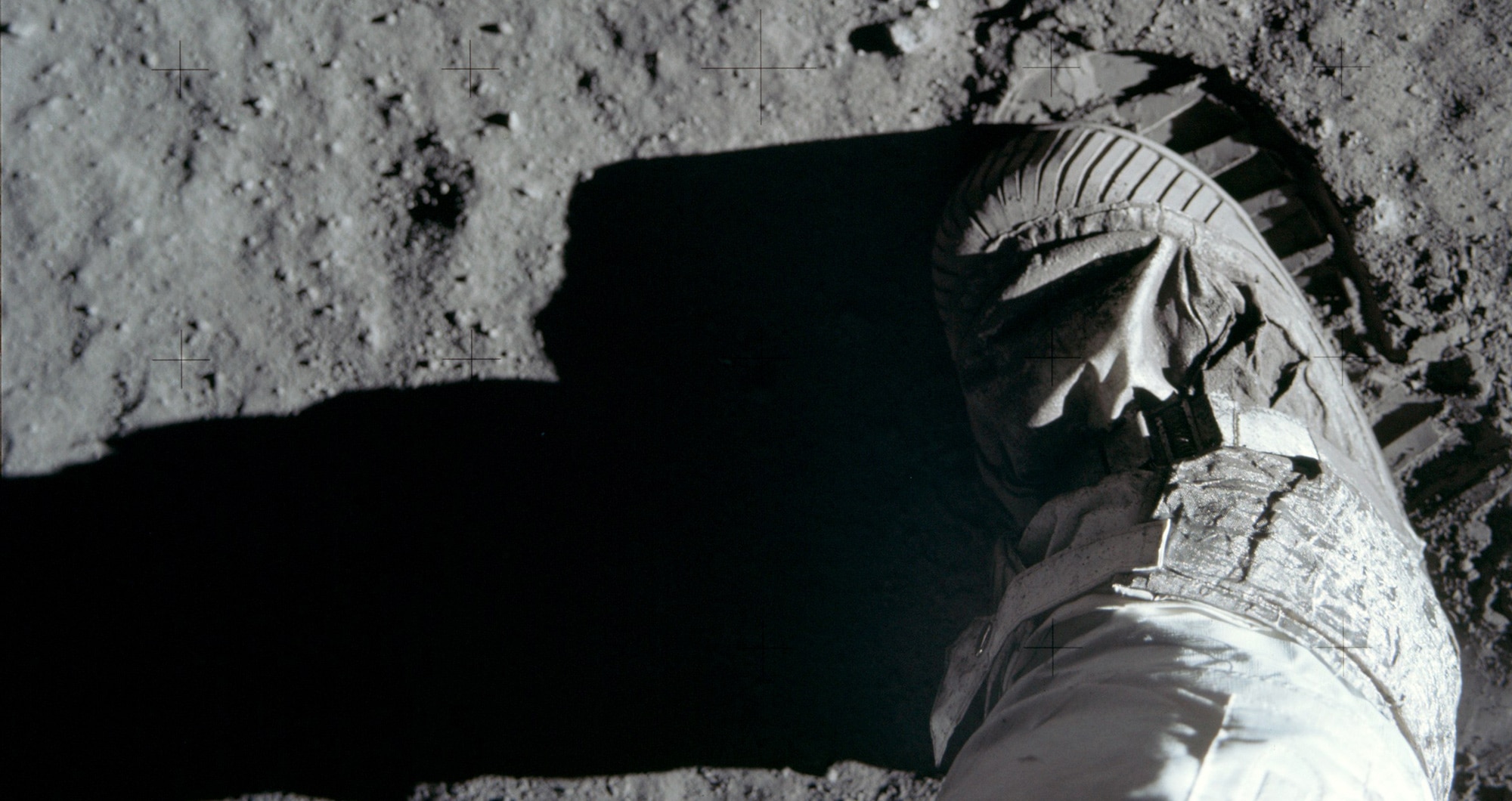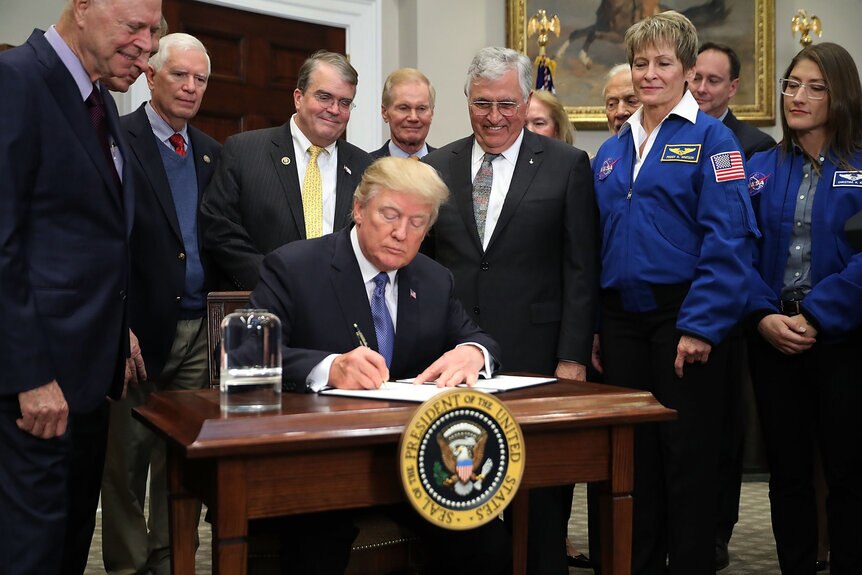Create a free profile to get unlimited access to exclusive videos, sweepstakes, and more!
President Trump's new National Space Policy isn't exactly a giant leap

On December 11, 2017, with some fanfare and a handful of NASA astronauts looking on, President Trump signed a new version of the United States National Space Policy — a document that outlines the goals of the country's space efforts and the implementation thereof.
My reaction: Meh.
That's probably not what you expected, but then, this event was exactly what I expected: A lot of pomp but no real circumstance.
The reason I say this is twofold: One is that this new version of the document is almost identical to the previous version, with some minor changes that, in my opinion, don't mean much. The other is that Trump and his administration make a lot of promises, but the vast majority of these turn out to be fantasy.
The last version of this policy was signed by President Obama in 2010. It was 14 pages long. The new version replaces just a few lines. Most notably, on Page 11, this paragraph in the old version:
Set far-reaching exploration milestones. By 2025, begin crewed missions beyond the moon, including sending humans to an asteroid. By the mid-2030s, send humans to orbit Mars and return them safely to Earth …
is replaced with this:
Lead an innovative and sustainable program of exploration with commercial and international partners to enable human expansion across the solar system and to bring back to Earth new knowledge and opportunities. Beginning with missions beyond low-Earth orbit, the United States will lead the return of humans to the Moon for long-term exploration and utilization, followed by human missions to Mars and other destinations.
There are some key differences here. Not long after Obama signed his version, the idea of sending astronauts to an asteroid fell out of favor (because it would be incredibly difficult, and the goal didn't make a lot of sense). Also, now, getting astronauts to the Moon by 2025 on a NASA rocket may not be achievable; delays in the huge rocket known as the Space Launch System (SLS) make that date nearly impossible. The first launch likely won't be until 2020, and the first crewed launch some years later. That also means sending humans to Mars will take a lot longer.
But note what the new version says: a return to the Moon and then a more vaguely phrased bit about going beyond.
I'm all for going back to the Moon, and doing so sustainably. I've written about this many times. The Apollo missions were amazing, colossal achievements, but in the end it was a race with the Soviets to reach the Moon, and what happens after you win a race? You go home. In the end, Apollo was not sustainable for many reasons, mostly due to money and the waning public interest once the race was won. If we go back, we have to be more careful and do it in such a way that it makes sense, and gets us there to stay.
In that sense, this new text addition makes sense. Cooperating with commercial industry — notably SpaceX in the very near term and likely Blue Origin as well a few years later — will make access to the Moon far cheaper and more reliable than SLS will be, by a large margin. So I'm good with that.
But note what the text doesn't say. There are no dates! And that, I think, is the major problem here. With no dates and no timeline, the chances of this policy being executed in any reasonable timeframe drops. One reason we got to the Moon in 1969 was that Kennedy made it the very well-publicized goal, and the nation got behind him. Of course the global political environment today is far different, but without any sort of date in there I don't think this policy means much. Heck, Obama had dates in his and it still didn't amount to much. Without them there's even less momentum behind this.
Not everyone agrees with me. Former Congressperson Bob Walker (R-Pennsylvania) wrote an op-ed in SpaceNews strongly supporting this new policy. I have to admit scratching my head over it. He opens with this line:
President Trump just articulated a dramatic new direction for America's space presence.
I'm not seeing that at all in this policy. Sure, it says we're going back to the Moon, but that's hardly a "dramatic new direction." We've been talking about doing that for years. He also praises Trumps "call for increased collaboration," but the old policy also did exactly that:
Implement a new space technology development and test program, working with industry, academia, and international partners to build, fly, and test several key technologies that can increase the capabilities, decrease the costs, and expand the opportunities for future space activities.
So I disagree that this new version says much that's either innovative or dramatic.
But there's more. This document outlines the policy from the Executive Branch level, but it's Congress that has to work with this as a guideline to implement it, and more importantly, fund it.
That's a whole process. First, NASA works with the president to outline a budget request. This then goes to Congress, where the House and Senate work out individual budgets, then get together for reconciliation. This completed budget then goes to the president to approve (or not).
That process has already been done for the next fiscal year; the White House released its request earlier this year, Congress already worked through their version as well. As of right now it's part of the federal budget, but that has not yet been enacted by Congress (debate didn't even start on the budget until after it was supposed to go into effect, and a Continuing Resolution to temporarily fund the government has been enacted until January 18, 2018). So any new policy won't even have a chance to go into effect until the next NASA budget is hammered out sometime next year.
It will be very interesting to see what both the White House and Congress intend to do with this new policy, slightly variant as it is. Will NASA get the money it needs to actually implement a return to the Moon?
To be honest, I doubt it. Traditionally, NASA has been given just barely enough money to do what it needs to do, but not really enough to do anything more. When some NASA program runs over budget, historically other programs take a hit to give it money to continue. Adding a return to the Moon over and above what NASA is doing now will mean an additional several billion dollars every year. That seems doubtful.
And I'll note that Trump isn't the first president to say we're going back to the Moon. Both Bush Sr. and Jr. tried it, and those programs went nowhere (Obama canceled Bush Jr.'s Constellation program, rightly so in my opinion, but didn't replace it with anything that could do the job; the politics got tangled, SLS was proposed in 2010 as a compromise, and, well, here we are). Without huge support by Congress, I suspect this new policy will have the same fate.
And that, in the end, is why I'm so "meh" about this. Sure, I'd love to see us go back to the Moon. And I think we can do it with a partnership between NASA, other countries, and commercial endeavors. I've been clear about this for a long time.
But I just don't see much new here, and we just saw what Congress' priorities are. With the GOP already sharpening their knives and eyeing Medicare and other critical programs, in this environment it's hard for me to see how NASA will get the additional gigabucks needed to do what this policy says.
I hope I'm wrong. But one thing we've seen, over and again this past year, is that this administration promises a lot, and delivers very little.



























